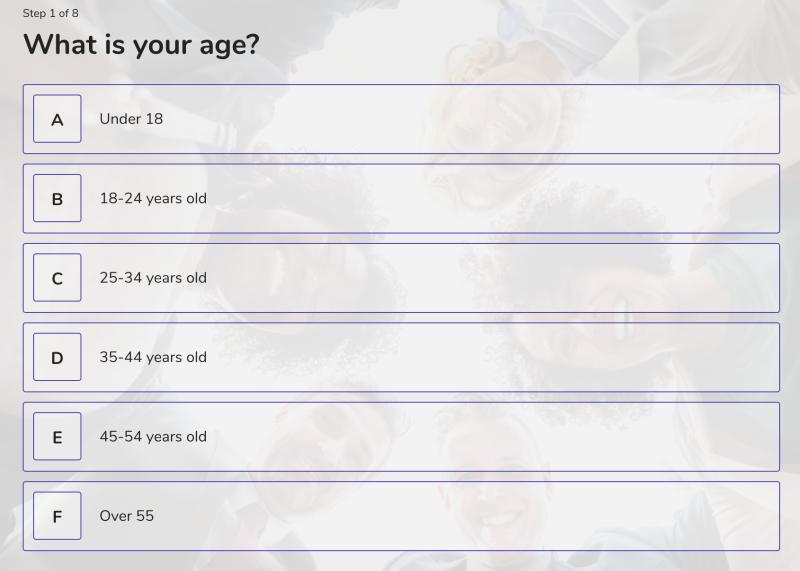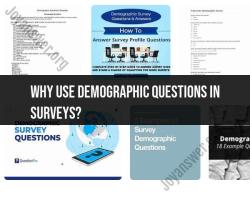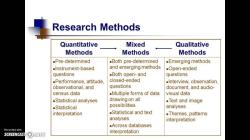What are common demographic questions?
Common demographic survey questions gather information about characteristics such as age, gender, race, ethnicity, income, education, marital status, household size, and location. These questions help researchers and organizations understand their audience, tailor services or products, and make informed decisions. Here are examples and their applications:
Age: "What is your age?"
- Application: Understanding age distributions helps in market segmentation, policy-making, and product development targeted to specific age groups.
Gender: "What gender do you identify as?"
- Application: Allows for gender-based analysis in health, marketing, and social services to ensure inclusivity and tailored approaches.
Race/Ethnicity: "What is your race/ethnicity?"
- Application: Aids in understanding diversity, representation, and disparities in healthcare, education, and employment.
Income: "What is your annual household income?"
- Application: Assists in determining economic disparities, consumer behavior, and eligibility for certain programs or services.
Education: "What is the highest level of education you have completed?"
- Application: Helps assess educational needs, workforce planning, and targeting specific educational programs.
Marital Status: "What is your marital status?"
- Application: Understanding family structures, social behavior, and household dynamics for various services or programs.
Household Size: "How many people live in your household?"
- Application: Useful for housing planning, resource allocation, and understanding consumption patterns.
Location: "What is your ZIP code?"
- Application: Helps in geographic targeting, localizing marketing strategies, and understanding regional differences in needs.
Occupation: "What is your current occupation?"
- Application: Aids in understanding workforce distribution, employment trends, and tailoring career-related services.
Language Spoken at Home: "What language do you primarily speak at home?"
- Application: Helps in designing multilingual services, communication strategies, and assessing language-specific needs.
When collecting demographic data, it's crucial to ensure questions are phrased sensitively, offer diverse options, and allow respondents to skip if they prefer not to answer. This information should be handled with care to respect privacy and confidentiality.
Demographic questions are a common and essential part of surveys and research studies, providing valuable insights into the characteristics, perspectives, and behaviors of different populations. These questions typically cover a range of topics, including age, gender, race, ethnicity, education level, occupation, and income level.
Frequently Asked Demographic Questions
Age: Age is a fundamental demographic variable that can influence various aspects of life, such as preferences, behaviors, and perceptions.
Gender: Gender, typically categorized as male, female, or non-binary, is an important demographic factor that can influence experiences, attitudes, and opportunities.
Race: Race is a social construct that categorizes people based on shared ancestry, physical characteristics, and cultural heritage.
Ethnicity: Ethnicity refers to a person's cultural identity, often based on shared language, traditions, and national origin.
Education Level: Education level indicates the extent of formal education a person has attained, such as high school diploma, bachelor's degree, or postgraduate studies.
Occupation: Occupation refers to a person's job or profession, providing insights into their skills, interests, and socioeconomic status.
Income Level: Income level indicates a person's annual or household earnings, potentially influencing their purchasing power, lifestyle choices, and financial opportunities.
Purpose of Collecting Demographic Data
Demographic data plays a crucial role in surveys and research studies, serving several key purposes:
Understanding Target Audiences: Demographic information helps to identify and segment target audiences based on their shared characteristics. This allows for more targeted marketing campaigns, product development, and policy decisions.
Tailoring Survey Questions: Demographic data enables researchers to tailor survey questions to the specific interests and experiences of different demographic groups. This can lead to more relevant, engaging, and informative responses.
Analyzing Survey Responses: Demographic data can be used to analyze survey responses and identify patterns or trends within different demographic subgroups. This can reveal variations in opinions, preferences, or behaviors among different demographic groups.
Gaining Insights into Specific Demographics: Demographic data provides valuable insights into the characteristics, attitudes, and behaviors of specific demographic groups. This can inform decision-making in various fields, such as education, healthcare, and social services.
Responsible and Ethical Use of Demographic Information
While demographic data is valuable for research and marketing purposes, it is crucial to ensure its ethical and responsible use. Key considerations include:
Privacy Protection: Demographic data must be collected, stored, and used in a manner that protects the privacy of individuals. Consent should be obtained, and data should be anonymized or aggregated to protect individual identities.
Non-discrimination: Demographic data should not be used to discriminate against or unfairly disadvantage individuals or groups. Data should be analyzed and used in a way that promotes equality and fairness.
Transparency and Accountability: The collection and use of demographic data should be transparent and accountable. Individuals should be informed about how their data is being collected, used, and protected.
Data Security: Demographic data should be safeguarded against unauthorized access, misuse, or loss. Proper data security measures should be implemented to protect sensitive information.
By adhering to ethical principles and ensuring responsible data practices, researchers and survey creators can maximize the value of demographic data while respecting the privacy and rights of individuals.













